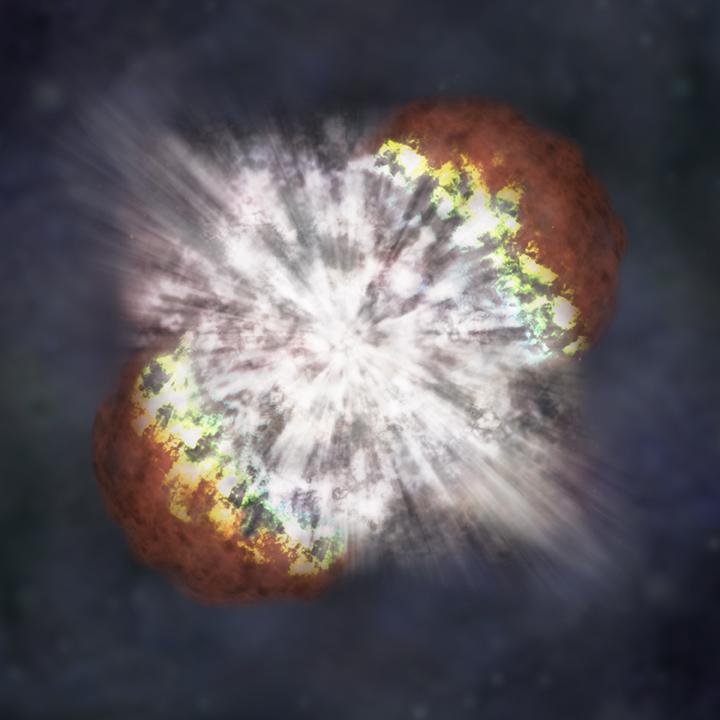
Credit: NASA
LAWRENCE — Did ancient supernovae induce proto-humans to walk on two legs, eventually resulting in homo sapiens with hands free to build cathedrals, design rockets and snap iPhone selfies?
A paper published today in the Journal of Geology makes the case: Supernovae bombarded Earth with cosmic energy starting as many as 8 million years ago, with a peak some 2.6 million years ago, initiating an avalanche of electrons in the lower atmosphere and setting off a chain of events that feasibly ended with bipedal hominins such as homo habilis, dubbed “handy man.”
The authors believe atmospheric ionization probably triggered an enormous upsurge in cloud-to-ground lightning strikes that ignited forest fires around the globe. These infernos could be one reason ancestors of homo sapiens developed bipedalism — to adapt in savannas that replaced torched forests in northeast Africa.
“It is thought there was already some tendency for hominins to walk on two legs, even before this event,” said lead author Adrian Melott, professor emeritus of physics & astronomy at the University of Kansas. “But they were mainly adapted for climbing around in trees. After this conversion to savanna, they would much more often have to walk from one tree to another across the grassland, and so they become better at walking upright. They could see over the tops of grass and watch for predators. It’s thought this conversion to savanna contributed to bipedalism as it became more and more dominant in human ancestors.”
Based on a “telltale” layer of iron-60 deposits lining the world’s sea beds, astronomers have high confidence supernovae exploded in Earth’s immediate cosmic neighborhood — between 100 and only 50 parsecs (163 light years) away — during the transition from the Pliocene Epoch to the Ice Age.
“We calculated the ionization of the atmosphere from cosmic rays which would come from a supernova about as far away as the iron-60 deposits indicate,” Melott said. “It appears that this was the closest one in a much longer series. We contend it would increase the ionization of the lower atmosphere by 50-fold. Usually, you don’t get lower-atmosphere ionization because cosmic rays don’t penetrate that far, but the more energetic ones from supernovae come right down to the surface — so there would be a lot of electrons being knocked out of the atmosphere.”
According to Melott and co-author Brian Thomas of Washburn University, ionization in the lower atmosphere meant an abundance of electrons would form more pathways for lightning strikes.
“The bottom mile or so of atmosphere gets affected in ways it normally never does,” Melott said. “When high-energy cosmic rays hit atoms and molecules in the atmosphere, they knock electrons out of them — so these electrons are running around loose instead of bound to atoms. Ordinarily, in the lightning process, there’s a buildup of voltage between clouds or the clouds and the ground — but current can’t flow because not enough electrons are around to carry it. So, it has to build up high voltage before electrons start moving. Once they’re moving, electrons knock more electrons out of more atoms, and it builds to a lightning bolt. But with this ionization, that process can get started a lot more easily, so there would be a lot more lightning bolts.”
The KU researcher said the probability that this lightning spike touched off a worldwide upsurge in wildfires is supported by the discovery of carbon deposits found in soils that correspond with the timing of the cosmic-ray bombardment.
“The observation is that there’s a lot more charcoal and soot in the world starting a few million years ago,” Melott said. “It’s all over the place, and nobody has any explanation for why it would have happened all over the world in different climate zones. This could be an explanation. That increase in fires is thought to have stimulated the transition from woodland to savanna in a lot of places — where you had forests, now you had mostly open grassland with shrubby things here and there. That’s thought to be related to human evolution in northeast Africa. Specifically, in the Great Rift Valley where you get all these hominin fossils.”
Melott said no such event is likely to occur again anytime soon. The nearest star capable of exploding into a supernova in the next million years is Betelgeuse, some 200 parsecs (652 light years) from Earth.
“Betelgeuse is too far away to have effects anywhere near this strong,” Melott said. “So, don’t worry about this. Worry about solar proton events. That’s the danger for us with our technology — a solar flare that knocks out electrical power. Just imagine months without electricity.”
###
Media Contact
Brendan M. Lynch
[email protected]
Related Journal Article
http://dx.




